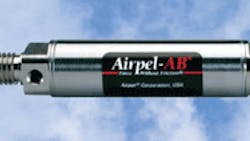Cylinders with Air Bearings
Engineering Staff
Airpot Corp.
Norwalk Conn.
Air bearings are motion components that are commonly integrated into linear actuation systems to reduce friction. They are particularly logical for systems already fed with air to drive pneumatic actuators moving supported load. However, for the pneumatic actuators to be equally low in friction, they must be constructed such that the air supply fed to the cylinder for actuation can also be used to produce an air cushion that supports the piston circumferentially — and prevents its contact with the cylinder wall.
An air bearing pneumatic cylinder requires specially engineered inner surfaces to consistently generate the correct internal airflow characteristics. In some designs, a shaped stainless-steel piston is precisely fitted to a borosilicate (or Pyrex) glass cylinder to create the air-bearing effect around the piston. With as little as 5 psi applied to the cylinder, the piston can be frictionless with virtually unlimited life.
Small viscous shear force
When the linear actuator uses supply air to create an air bearing for the piston, a very small but non-zero viscous shear force does oppose piston motion. Sometimes interpreted as friction, this force is not the same as Coulomb friction, since viscous shear only acts when the piston has non-zero velocity. In fact, it's actually a damping force directly proportional to piston velocity.
Eliminating rod seal and rod guide to eliminate friction
Certain single-acting air bearing cylinders need no self-support for the rod and use no rod guide bushing, so they can avoid sliding contact. In these units, the piston is connected to the rod with a ball-and-socket joint, and another such joint connects to a guided load.
A small amount of friction can be created in the ball-and-socket joints, because even with straight-line motion, the balls rotate in the sockets to compensate for the inherent bit of misalignment between the cylinder and load axes. The ball-joint friction may appear as piston friction but actually it is not, and the movement of these low-friction joints changes the output force by only a few grams or less.
Stiction: Unpredictable but preventable
Stiction is the notorious affliction that causes air cylinders to stick at the start of a stroke — resulting in erratic breakaway motion. It's the difference between static and moving friction when the static friction is higher.
Air cylinders engineered with air-bearing operation are inherently free of perceptible stiction — even at very low pressures and speeds, or after standing idle for years. Capable of forces up to 58 kg with accuracy as precise as 2 g, they are suitable for applications requiring ultra-smooth motion, at low pressures — driving lightweight or delicate loads, or counterbalancing vertical loads with precise force control.
Limitation considerations
These units should not be dropped; they should not be subject to side loads. Air cylinders with air-bearing operation should not be lubricated. In addition, input air should be filtered to remove debris down to 1 µm. Finally, to prevent bottoming out, a minimum pressure should be maintained.
Suitable applications
Cylinders with air bearing pistons output smooth motion — and they can greatly increase the longevity of pneumatic systems used for:
-
The tensioning of ultra-fine wire, filaments, or fiber
-
Positioning mechanisms supporting delicate optics
-
Sensitive force control for holding or clamping fragile materials
-
Counterbalancing and safety support for vertically positioned linear-motor-driven masses such as CMM measurement probes
-
Precise laboratory test equipment for weighing, measuring, tensile strength, and deformation.
For more information, call (800) 848-7681 or visit airpot.com. For video demonstrations, visit youtube.com and search Airpel.
